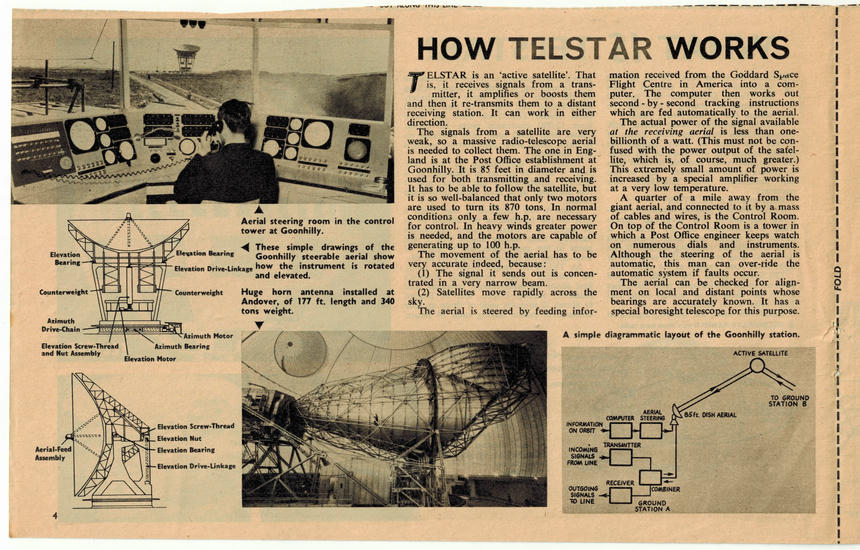Scrapbook 3: The Story of Telstar (4)

HOW TELSTAR WORKS
TELSTAR is an ‘active satellite’. That is, it receives signals from a transmitter, it amplifies or boosts them and then it re-transmits them to a distant receiving station. It can work in either direction.
The signals from a satellite are very weak, so a massive radio-telescope aerial is needed to collect them. The one in England is at the Post Office establishment at Goonhilly. It is 85 feet in diameter and is used for both transmitting and receiving. It has to be able to follow the satellite, but it is so well-balanced that only two motors are used to turn its 870 tons. In normal conditions only a few h.p. are necessary for control. In heavy winds greater power is needed, and the motors are capable of generating up to 100 h.p.
The movement of the aerial has to be very accurate indeed, because:
(1) The signal it sends out is concentrated in a very narrow beam.
(2) Satellites move rapidly across the sky.
The aerial is steered by feeding information received from the Goddard Space Flight Centre in America into a computer. The computer then works out second-by-second tracking instructions which are fed automatically to the aerial.
The actual power of the signal available at the receiving aerial is less than one-billionth of a watt. (This must not be confused with the power output of the satellite, which is, of course, much greater.) This extremely small amount of power is increased by a special amplifier working at a very low temperature.
A quarter of a mile away from the giant aerial, and connected to it by a mass of cables and wires, is the Control Room. On top of the Control Room is a tower in which a Post Office engineer keeps watch on numerous dials and instruments. Although the steering of the aerial is automatic, this man can over-ride the automatic system if faults occur.
The aerial can be checked for alignment on local and distant points whose bearings are accurately known. It has a special boresight telescope for this purpose.
Aerial steering room in the control tower at Goonhilly.
These simple drawings of the Goonhilly steerable aerial show how the instrument is rotated and elevated.
Huge horn antenna installed at Andover, of 177 ft. length and 340 tons weight.